Yesterday’s live coverage of the Ukraine conflict can be found here. An archive of our liveblogs can be found here. For an overview and analysis of this developing story see our latest podcast.
Please help The Interpreter to continue providing this valuable information service by making a donation towards our costs.
For links to individual updates click on the timestamps.
For the latest summary of evidence surrounding the shooting down of flight MH17 see our separate article: Evidence Review: Who Shot Down MH17?
The last two spot reports from the OSCE Special Monitoring Mission to Ukraine (SMM) have described significant quantities of military hardware in separatist-held territory east of Volnovakha, between Telmanovo and Starobeshevo.
This is of particular note given the recent assaults on Marinka and intensification in attacks on Granitnoye, Novolaspa and Starognatovka, as well as attacks on Ukrainian forces on the Donetsk-Mariupol highway last week.
According to the today’s SMM report, based on data received as of 19:30, June 8:
In “DPR”-controlled Rozdolne [Razdolnoye] (47km south-east of Donetsk) an SMM UAV spotted a concentration of nine main battle tanks (MBTs) in a residential area, one self-propelled howitzer (2S1) and 16 armoured personnel carriers (APCs).
While yesterday, the SMM report, based on data received as of 19:30, June 7, said:
Of particular note – amongst the weapons observed by SMM UAVs was a concentration at a railway station between the “DPR”-controlled Komsomolske [Komsomolskoye] (45km south-east of Donetsk) and Andriivka [Andreyevka] (45km south-east of Donetsk), namely seven MBTs. In the same area, the UAV spotted 35 military trucks and 25 armoured personnel carriers. Also, of note was a concentration around “DPR”-controlled Oktyabr (85km south of Donetsk), namely, three artillery pieces and two MBTs.
The sightings at the railway station south of Komsomolskoye and near Rozdolnoye are indicated by squares.

Furthermore, back on April 27, the OSCE reported that, over the previous three days, their UAV had
“sighted seventeen tanks, three self-propelled howitzers and 60 APCs in a “DPR”-controlled area 50 kilometres north of Shyrokyne.”
As we wrote at the time, the area 50 kilometres north of Shirokino once again separatist-held territory north of Granitnoye and Telmanovo.
On May 28, the OSCE SMM had an interesting encounter in Petrovskoye (Petrivske), around 15 kilometres west of both Komsomolskoye and Razdolnoye:
In Petrivske (“DPR”-controlled, 38km south-east of Donetsk) the SMM spoke to a young man who said that the former local holiday camp was currently occupied by an unknown armed group. He could not specify for how long this armed group had been stationed in the village. In the village the SMM spoke to two women, both wearing military uniforms, with caps with Russian Federation Armed Forces insignia. They said that they were from Kramatorsk. During the conversation with the two women a vehicle with Russian Federation number plates stopped next to the OSCE vehicles and two armed men, similarly dressed, exited the car and ordered the women to stop the conversation with the SMM. Behind a tall fence inside the holiday camp, the SMM observed one infantry fighting vehicle.
What this means is that Russian regular forces are gathering in an area of considerable strategic importance whilst attacks are escalating.
Here is a selection of recent reports of attacks in the area:
On June 7, there were reports of shelling in Granitnoye from both residents on social media and the Ukrainian military.
According to the reports, Granitnoye was shelled with Grad MLRS while Ukrainian positions near Novolaspa were attacked by tanks and armoured personnel carriers.
On June 6, the Ukrainian military claimed that Granitnoye and Starognatovka had been shelled with Grad MLRS.
On June 5, the Ukrainian military reported that Granitnoye had been shelled the previous night with both 122 mm artillery and Grad MLRS.
Meanwhile, the attacks on Marinka have heralded a new round of attacks on the highway between Donetsk and Mariupol, with Ukrainian positions at Taramchuk and Beryozovoye coming under fire.
The reason this area, between the highway and Granitnoye, is so important is that any serious move against Mariupol, the economic powerhouse of the Donetsk region, would require a pincer strategy – cutting off the Ukrainian supply road from the north by taking Volnovakha.
To the south of Granitnoye, Ukrainian positions are somewhat protected from assault by the Pavlopol reservoir, but the stretch of land between the highway and Granitnoye is open and vulnerable to mechanised forces.
This is where Russia would launch the offensive, and the preparations for it seem to be under way.
— Pierre Vaux
Yesterday, June 8, Pavel Gubarev, the former “people’s governor” of the self-proclaimed “Donetsk People’s Republic” (DNR), was arrested after a shooting incident, and then released.
LifeNews reported that Gubarev was detained along with 15 people after unknown persons, apparently from the DNR forces, opened fire from the SkyCity empty office building, evidently from an SVD [Dragunov snipers’ rifle]. Agents from the DNR’s Ministry of State Security (MNB) went to the scene and closed off Artyom street and surrounded the building, then dragged out the suspects and threw them to the ground. They reportedly were able only to find a pistol.
Ukrainian press had a different version of the story.
Translation: Motorola’s group seized the DNR Communications Ministry and Gubarev – Interior Ministry
Vyacheslav Abroskin, head of the Donetsk branch of the Ukrainian Interior Ministry, told 62.ua that “the DNR’s Ministry of Communications was seized” reportedly by fighters from Motorola’s brigade with the help of armored vehicles. Motorola, the call sign of Arseny Pavlov, is the commander of the Spartak Battalion and among the most popular of the separatists. The ministry’s office is located in the SkyCity business center. Motorola was quoted as saying that 15 fighters were sent “to the republic’s drug clinic” for testing and that they were “drug addicts.”
62.ua reported Gubarev as saying:
“The incident with the surrounding of the SkyCity building took place,
but I had nothing to do with it. I am home now, everything is fine with
me. As for the rest, I believe the investigation should get to the
bottom of this situation,”
This latest affair was seen as another indication that the
“Novorossiya” cause was being wound up by Russia and even its proxies in
Donetsk. Yet Gubarev, once the “people’s governor” of Donetsk and the
main hero of the DNR has been far less visible since his resignation in September and less active since an
alleged assassination attempt on him last October when his car was shot
near the Russian border. His arrest among 15 people in what may have been infighting among the DNR fighters or a party gone out of control doesn’t necessarily signify a “hit” has been made on him.
Even when the assassination attempt was said to be made on him, there was speculation that the incident wasn’t war-related but some internal dispute. He didn’t suffer any gunshot wounds but was hospitalized with traumatic brain injury, then
recovered and resumed campaigning for the Novorossiya cause on talk
shows, and helping his wife Yekaterina Gubareva, one of the main
fund-raisers for “Novorossiya.”
Gubarev was briefly kidnapped — and quickly released — by
Chechens earlier this year, which shed light on the fact that Krasnodon
had been taken over by Chechen fighters — and Gubarev was still relevant enough to kidnap.
Russian-backed fighters
continue to use the Novorossiya flag and insignia and proclaim its
ideals as we can see from a recent convoy May 29 moving into position for what
turned out to be the June 3 offensive. There are many other recent instances of the
flag and rhetoric. The leadership of the DNR and LNR may be forced into
some seeming compromise as their recent statements indicate but they
continue to take over Ukrainian territory and kill Ukrainians.
— Catherine A. Fitzpatrick
There are reports of shelling in western Donetsk this evening.
Translation: Again something is burning in the city centre 19:05
Some reports are placing the fires in the Tekstilshchik area, in the south-west, nearer to the front line with Marinka, while others claim it is in the Grabari area, closer to the city centre, in the Kuybyshevsky district.
There are also reports of strikes on Isakova street, north of Aleksandrovka, right on the edge of separatist-held territory:
Translation: #Donetsk Isakova street. Incoming. No casualties.
Meanwhile, Donetsk news site 62.ua reports shells striking residential areas in the city’s north, just south of the ruined airport.
According to the report, shells struck the following sites:
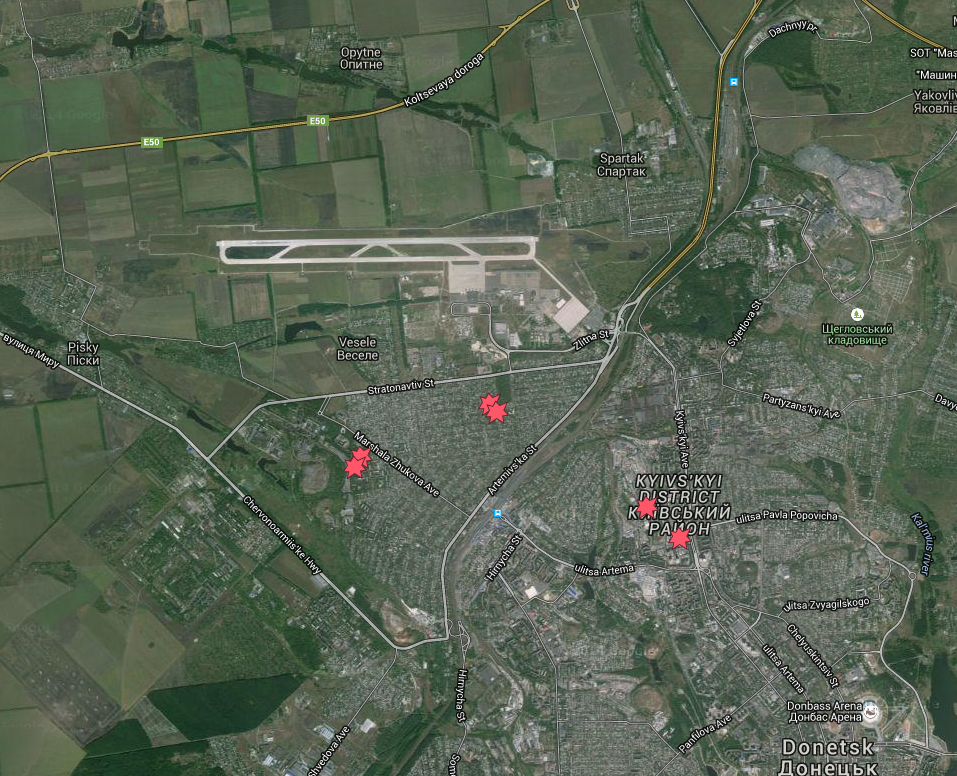
— Pierre Vaux
Last night the Russian-backed separatist leadership published a document which contained their proposed additions and amendments to the Ukrainian constitution. In the document, the separatists acknowledge not only the ‘separate areas of the Donetsk and Lugansk regions,’ but the Autonomous Republic of Crimea as integral parts of Ukraine.
While this may be seen as a move of acquiescence towards Kiev, it is in fact undermined by both the reality of the situation in the Donbass and other proposed amendments in the document.
Most important of all is that the local elections which must be held in the occupied territories as part of the ‘Special Status’ law passed by Ukraine in accordance with the Minsk agreements, are, Kiev says, only to be conducted once the Ukraine has full control over its borders, another point of the Minsk text.
There is no sign whatsoever that this is going to happen any time soon. The Russian-backed forces are not even allowing OSCE monitors to inspect most of the border, across which Russian troops and armour move freely. With such a state of affairs, the disputes between the separatists and Kiev on the manner in which the elections are to be held are moot.
Key sticking points in the separatists’ proposals, that were evident when their representatives first submitted the draft document to the tripartite Contact Group on May 13, are still present.
These include the separatists’ insistence that Ukraine be constitutionally obliged to pursue a ‘non-aligned’ status internationally, barring Ukraine from applying for EU or NATO membership.
The Ukrainian government has made it clear that it considers membership of both groups to be key foreign policy goals.
The proposals published last night also retain the demand for “people’s militia,” the leadership of which is to be appointed by the local government, who would remain in their posts according to the text.
This document therefore offers nothing but pro forma adherence to the Minsk agreements.
— Pierre Vaux
On June 3 the Russian-backed fighters in eastern Ukraine launched a major attack against Marinka, southwest of Donetsk. The United States Ambassador to the United Nations, Samantha Power, did not bury the U.S. assessment — she said that the Russian Federation and its “separatist allies” had launched a joint attack west of the Minsk demarcation line at Marinka and Krasnohorivka, and then their own contradictory statements undercut their narrative that Ukraine started the fight.
Over the last week we have made several attempts to explain the strategic importance of this battle and the escalating campaign in eastern Ukraine, but each day new fighting occurs across the front. The question, then, is how well the trends and models are holding up in light of new evidence and developments on the ground.
In our initial assessment, we noted that when the battles are mapped, a pattern emerges:
The capture of Marinka, southwest of Donetsk, would advance the goals of the Russian-backed fighters in several ways. The first and most obvious is that it would help secure Donetsk. The second, though, is that it would put the Russian-backed fighters one step closer to cutting off Mariupol, to the south.
But across all of the front lines — near Mariupol, Donetsk, Gorlovka, and Schastye — we see a similar pattern emerge. The Russian-backed fighters are advancing in what could be described as “fingers,” narrow points of focus which are fairly evenly spaced. The pattern is that regular, but not constant, fighting is reported at alternating fingers on different days. This has several effects — it tests Ukraine’s lines and keeps them guessing where the next attack will come. As a result, the Russian-backed forces have been able to advance in narrow “spiky” channels, and each advance carries with it a new threat — encirclement. As two or more neighboring fingers advance deeper into Ukrainian territory, the Ukrainian military is in danger of being trapped in a pincer between two fronts, a strategy that has proven to be highly effective in the conflict, most notably at Ilovaisk and Debaltsevo.
The theory, then, was that an assault which pushes outwards from Donetsk accomplishes two main goals — to threaten the highway that runs to Mariupol to the south, and to possibly catch Ukrainian military positions closer to Donetsk, either north or south of the city, in a pincer.
Two days later the Institute for the Study of War published their own assessment which closely corresponds to this theory:
For ISW’s report:
A sustained Russian-backed offensive on these frontline positions may function as component of a larger maneuver to push south along the strategic Donetsk-Mariupol highway. The maneuver around Donetsk may also be part of a coordinated tandem offensive, a signature of Russia’s hybrid operations in eastern Ukraine. Russian-backed separatists may synchronize the offensive west of Donetsk with a maneuver operation around the city of Artemivsk, a gateway to Ukraine’s regional military and administrative headquarters.
Yesterday, a new assessment of the fighting, written by The Interpreter‘s managing editor James Miller, was published in Foreign Policy:
In the days since the attack on Marinka, Russian-backed forces have launched smaller offensives north and northwest of Donetsk and from positions east of Mariupol. On June 8, the Ukrainian military reported that heavy fighting is once again raging in Marinka, and the Ukrainian military also seems increasingly concerned about attacks on the towns of Artyomovsk and Gorlovka, both north-northeast of Donetsk. Clearly, the June 3 attack on Marinka was part of a wider pattern and, presumably, a wider strategy of the separatists.
The target of this new offensive is not necessarily Marinka or Donetsk, the area of this newest wave of fighting, but the areas north and northwest of Luhansk, north and west of Gorlovka, and north and east of Mariupol. By conducting surprise attacks along the narrow corridors of the front lines, the rebels have been able to secure finger-like strips of land which, once expanded, could threaten to trap pockets of Ukrainian troops and the towns they defend in “pincers,” grinding Kiev’s forces like dough between fingers as they close into a fist. The separatists employed this same strategy to great effect last August in the battle for Ilovaisk and in the capture of Debaltseve in February.
We also carried a report on fighting at Svetlodarsk, northeast of Gorlovka and southeast of Artyomovsk, near an important reservoir. In order to advance further toward Artyomovsk, Russian-backed forces would have to secure this area, and Ukrainian troops defending these positions are already in danger of being cut off and backed up against the water:
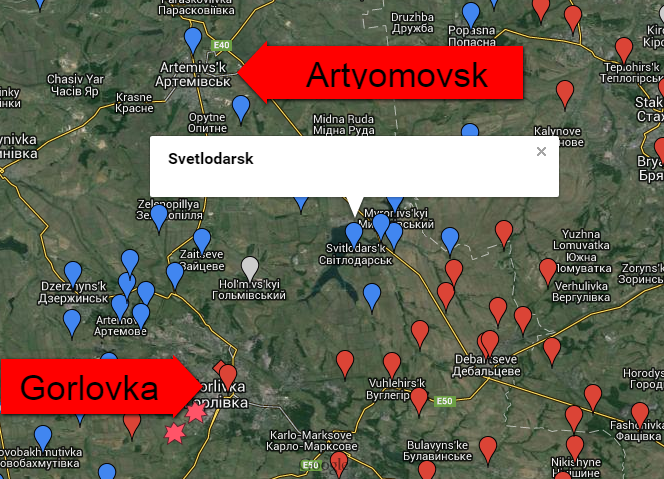
See our assessment here:
Details from the latest OSCE reports can also be used to track trends in fighting and troop movement. Here are some excerpts from the SMM report from June 7, 19:30 Kiev time:
On 7 June, while at a Ukrainian Armed Forces checkpoint in the vicinity of government-controlled Marinka (23km west, south-west of Donetsk), the SMM heard and saw SALW fire (7-10 single shots and at least 3-4 bursts) incoming from a north-easterly direction and impacting 3-5m next to SMM vehicles in sand bags and concrete blocks. The soldiers laid down for cover. The SMM immediately left the scene. No injuries or damage were reported.
An SMM UAV spotted a concentration of 40 military-type trucks in Petrovskyi district (“DPR”-controlled, 20km south-west of Donetsk city centre).
The Petrovskyi district played a key role on the Russian-backed assault on Marinka on June 3. The Interpreter’s editor-in-chief Michael Weiss wrote in The Daily Beast:
The two main towns hit today were Marinka and Krasnogorovka, both not far from the major industrial city of Donetsk. The nearest separatist lines to these targets are the Petrovsky district of the city to the east, Aleksandrovka to the southeast and Novomikhailkovka to the northeast. Video footage, purportedly shot in Petrovsky today, clearly recorded the sounds of outbound artillery fire, with the attendant description of the footage claiming that the separatists were firing from positions in the immediate vicinity of residential high-rises. (Of course, firing from civilian areas doesn’t just violate Minsk II, but the Geneva Conventions.)

Can Anyone Stop Putin's New Blitz?
It looks like Vladimir Putin will spend his second summer in a row going to war. So now the question becomes: What-if anything-will the United States and Europe do in response? On Wednesday, Ukrainians awoke to the all-too-predictable news that Moscow-backed separatists-a contingent that consists of quite a lot of Moscow-dispatched Russian soldiers-launched a fresh, multi-pronged assault on Ukrainian-held territory.
The June 7 OSCE report also carried another interesting excerpt about troop movement south of Donetsk (though, since the Ukrainian government was so blatantly attacked and said they were mobilizing their heavy weaponry in response, the lines about the Minsk agreement being broken are no longer really relevant):
Despite claims that the withdrawal of heavy weapons has been complete, the SMM observed the following weapons movements/presence in areas that are in violation of the Minsk withdrawal lines: in government-controlled areas, 14 main battle tanks (MBTs) and three artillery pieces; and, in “DPR”-controlled areas, 16 MBTs and five artillery pieces.
Of particular note – amongst the weapons observed by SMM UAVs was a concentration at a railway station between the “DPR”-controlled Komsomolske (45km south-east of Donetsk) and Andriivka (45km south-east of Donetsk), namely seven MBTs. In the same area, the UAV spotted 35 military trucks and 25 armoured personnel carriers. Also, of note was a concentration around “DPR”-controlled Oktyabr (85km south of Donetsk), namely, three artillery pieces and two MBTs.
On June 8 the OSCE saw more Russian-proxy armor southeast of Donetsk — note how large the convoys are in this area compared to other areas where military hardware was spotted:
In “DPR”-controlled Rozdolne (47km south-east of Donetsk) an SMM UAV spotted a concentration of nine main battle tanks (MBTs) in a residential area, one self-propelled howitzer (2S1) and 16 armoured personnel carriers (APCs). Eight towed artillery guns were seen by an SMM UAV in government-controlled Paraskoviivka (27km south-west of Donetsk). In “DPR”-controlled Yakovlivka (7km north-north-east of Donetsk) the SMM UAV saw three artillery pieces set up under camouflaged nets. In other “DPR”-controlled areas the SMM UAV saw five MBTs. At another location in a government-controlled area, the SMM observed a 120mm heavy mortar.
All this armor could easily strike positions between Donetsk and Mariupol, like at Volnovakha and/or Telmanovo, which would give the Russian-backed fighters two advantages — it would provide another angle to attack positions west of Donetsk, and it would apply even more pressure to Mariupol. Volnovakha was also highlighted by both the ISW’s and The Interpreter’s maps as a possible target.
In other words, the evidence-based assessments made by The Interpreter in the last weeks continue to bear fruit, even though most of the battles in eastern Ukraine are not making it to international headlines.
— James Miller
Stéphane Siohan, a French journalist working in eastern Ukraine, reports that the last transit point between Ukrainian and separatist-held territory in the Donetsk region near Gorlovka has been closed due to fighting this morning.
The transit point was located near Ukrainian-held Zaytsevo, about 7 kilometres north of separatist-held Gorlovka.
On June 1, the Ukrainian military claimed that the crossing point had been shelled with tanks and artillery while civilians were queuing to pass through.
Yesterday evening we reported on video footage showing smoke rising from the north-east of Gorlovka, towards the Ukrainian front line.
Gorlovka news site 06242.com.ua claimed this morning that Russian-backed forces had shelled the northern and north-western fringes of the town, as well as the village of Golmovsky last night.
Gorlovka.ua reported that two civilians were wounded in last night’s shelling of the Komsomolets and Kurganka areas. Houses were also destroyed in the Komarova area, which lies near where we saw smoke yesterday.
The site posted photos of the aftermath:
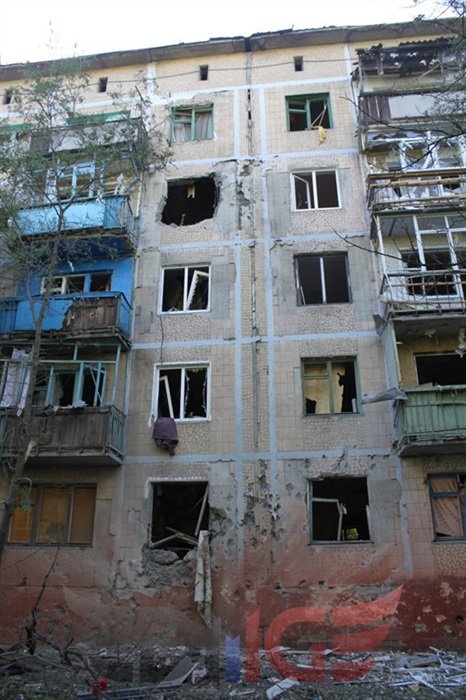
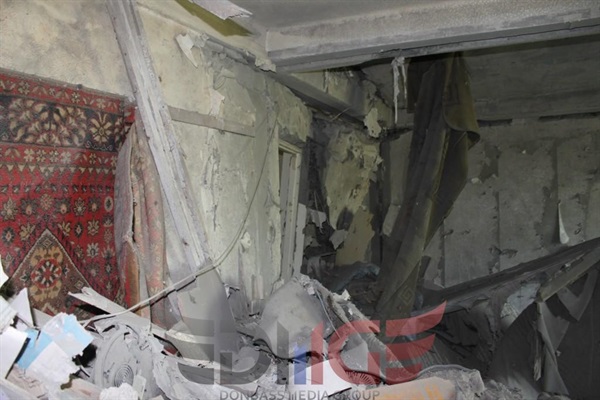
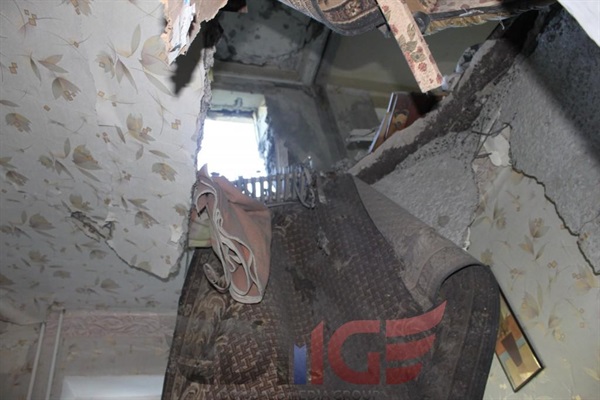
There was no claim in the report as to who had conducted this shelling.
— Pierre Vaux
Russia’s state-owned RIA Novosti news agency reports that Gazprom will not renew their gas transit contact with Ukraine after 2019.
The Interpreter translates:
Gazprom deputy chairman Aleksandr Medvedev said that “under no circumstances would any renewal or new contact be signed with Kiev and therefore the easiest way to ensure gas supplies to Turkey would be the ‘Turkish stream.'”
Previously, the Russian minister for energy, Aleksandr Novak, has repeatedly said that Russia is not planning to renew the contact for gas transit through Ukraine after 2019. The head of Gazprom, Aleksei Miller, has also spoken of Russia’s firm intention to refuse Ukraine’s services as a transit provider for Russian gas to Europe after 2019.
Meanwhile, the state-owned TASS news agency reported that Medvedev had said that Ukraine should pay for gas supplies to the occupied territories of the south-east.
“It is logical,” Medvedev said if Donetsk and Luhansk are parts of Ukraine.
Russia began supplying gas directly to the separatist-held areas via transit points beyond the control of Ukrainian gas authorities. Ukraine objected to this move as they could not monitor the flow of gas to verify supplies and regarded it as interference in domestic distribution.
— Pierre Vaux
Ukrainska Pravda reports that Andriy Lysenko, spokesman for the Presidential Administration on the military operation in the south-east, has told journalists at a briefing today that eight Ukrainian soldiers have been killed and five wounded over the last 24 hours.
Seven of the soldiers were killed yesterday when their truck struck a mine outside Krasnogorovka, west of Donetsk.
— Pierre Vaux
The press office of the governor of the Lugansk region, Hennadiy Moskal, reports that three houses were burnt down in Stanitsa Luganskaya after Russian-backed forces shelled the town with mortars last night.
According to the report, the shelling came from separatist-held territory on the southern banks of the Seversky Donets river.
An armed confrontation took place between Ukrainian troops and Russian-backed fighters near one of the ruined bridges across the river outside the town.
Moskal claimed that incendiary ammunition had been used by the Russian-backed forces during their bombardment.
As a result of the shelling, electricity is down in Stanitsa Luganskaya and seven surrounding villages.
Meanwhile, in Krymskoye, to the west, on the southern banks of the Seversky Donets, Moskal’s office reports that three Ukrainian servicemen from a police battalion were wounded after setting off a tripwire grenade at around 18:00 yesterday.
Fighting on the eastern outskirts had ended only an hour earlier.
First responders are still trying to cope with a huge fire at an oil depot near Kiev that started last night.
All 17 of the tanks at the depot in Kryachka in Vasilkov (Vasylkiv) District, 40 kilometers from Kiev are on fire now, RBC.ru reports, citing the Ukrainian TV station 112.
The blaze started last night for “technical reasons” say officials, and first involved only 4 of the tanks. Fire-fighters were unable to put out the flames, and there was an explosion and then the fire spread to the other tanks.
Translation: in Kiev measuring of the presence in the air of products of combustion from the fire in Vasilkov has begun.
There is concern the fire may spread to other facilities.
Translation: the fire at the oil depot in Vasilkov may spread to a military air field.
Translation: 50 meters from the burning tanks of the oil depot is an army arsenal, says Turchynov. “There is a serious danger.”
The army was addressing this danger:
The nearby forest has caught on fire.
Translation: Our company (BRSM-Nafta) believes this fire is a terrorist act – Melnichuk – LIVE
As of 11:55 am Kiev time, Ukrainska Pravda reported that authorities could not reach three firemen whose fate was unknown. There were earlier reports of firemen killed and wounded in the fire but currently the report is that 6 firemen have been injured.
Ten fire vehicles were destroyed in the attempts to battle the fire, says Ukrainska Pravda.
Mykola Nedilko, head of the town council in Vasilkov said the equipment was available but it was having little positive effect; “it just burns and burns.”
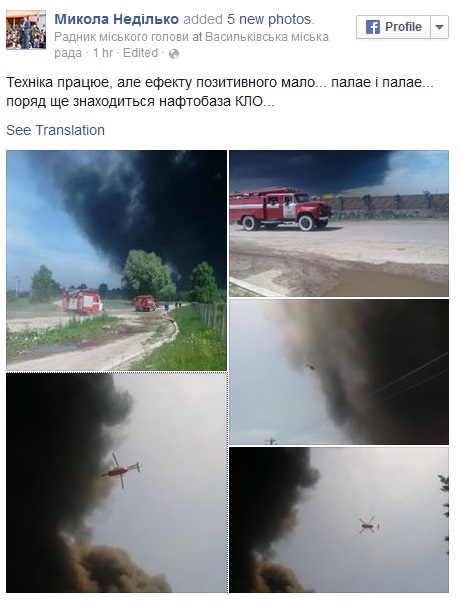
— Catherine A. Fitzpatrick
Leviy Bereg‘s Oleksandr Rudomanov reports that Ukrainian positions in Peski, north-west of Donetsk, were attacked throughout last night.
Rudomanov reports, citing soldiers on the front line, that shelling began at 21:00. Fire came from mortars, self-propelled guns and heavy-calibre machine guns. Soldiers said that the fire came from both the Volvo Centre, south-east of Peski, and the Zhobunki area, east of Peski.
A soldier from the Svoboda legion, with the call sign Myslyvets (hunter) said (translated by The Interpreter):
“The positions on the right defence flank of Peski came under a hail of shells. The shelling continued up until the morning. At around 6 am self-propelled guns shelled the crossroads and the medics’ yard. Everyone is safe. No wounded.”
At 9:06 GMT today, the following tweet was posted:
Translation: In Peski it’s started with small arms and continued with something heavier… They can’t even sit still during the day…
The Ukrainian military’s ATO Press Centre claimed today that Russian-backed forces had mounted attacks on other Ukrainian-held positions north of Donetsk.
Avdeyevka, and the Butovka mine were shelled with 120 mm mortars and 122 mm artillery while Opytnoye and Vodyanoye were also attacked by tanks. A residential building in the latter was struck with 122 mm shells. Fire was also directed at Krasnogorovka, north of Marinka.
Meanwhile, at 9:27 GMT, Donetsk news site 62.ua reported that an explosion had been heard to the east of the separatist-held city.
Plumes of smoke were seen rising from the Chervonogvardeysky district of Makeyevka, with this photo taken from the Svetochka neighbourhood to the south:
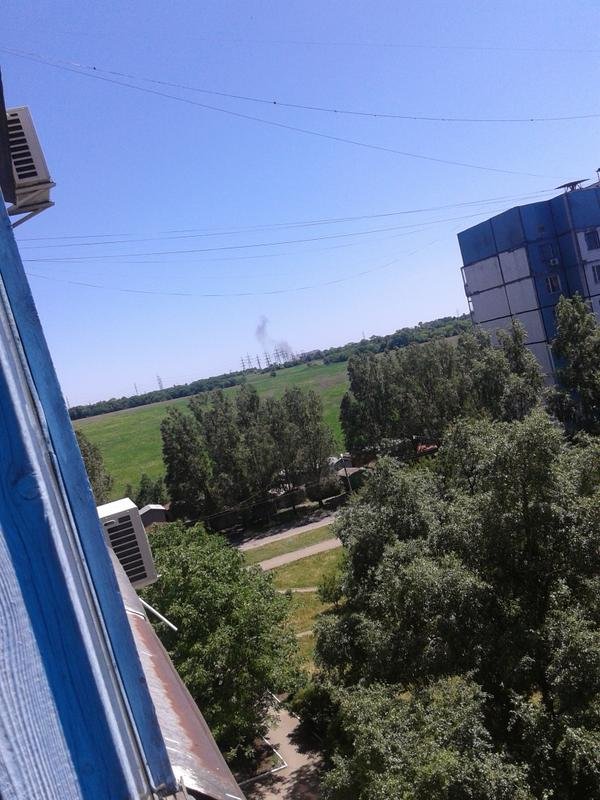
According to the report, residents head a “relatively powerful” bang at around 12:00 (9:00 GMT).
62.ua notes that one possible explanation is the disposal of unexploded ordnance.
— Pierre Vaux
Ukrainian firefighters are still battling the blaze involving at least 4 tanks at an oil plant in Kryachka, 40 kilometers from Kiev, as we reported late last night.
A company official had not ruled out arson, said Podrobnosti.ru.
Translation: Another four are out! 2 remain…
— Catherine A. Fitzpatrick
In recent days, the attention has been on Marinka, since a Russian-backed fighters’ offensive on that city June 3 and also on Gorlovka, as shelling continued there yesterday, June 8.
Other battles in smaller towns or in areas with less information have been overshadowed, yet the news from these areas indicates Russian-backed separatist pressure on these Ukrainian-held areas as well.
Svetlodarsk (Svitlodarsk) is 18 kilometers north of Debaltsevo and 10 kilometers from Logvinovo, the last separatist-controlled village before the line of contact. These towns are on the road to Artyomevsk, a Ukrainian-held hub.
The Ukrainian National Security and Defense Council map for June 3 shows Svetlodarks with flames nearby.
MilitaryMaps.info, a pro-Russian website shows Svetlodarsk and Luganskoye under Ukrainian control.
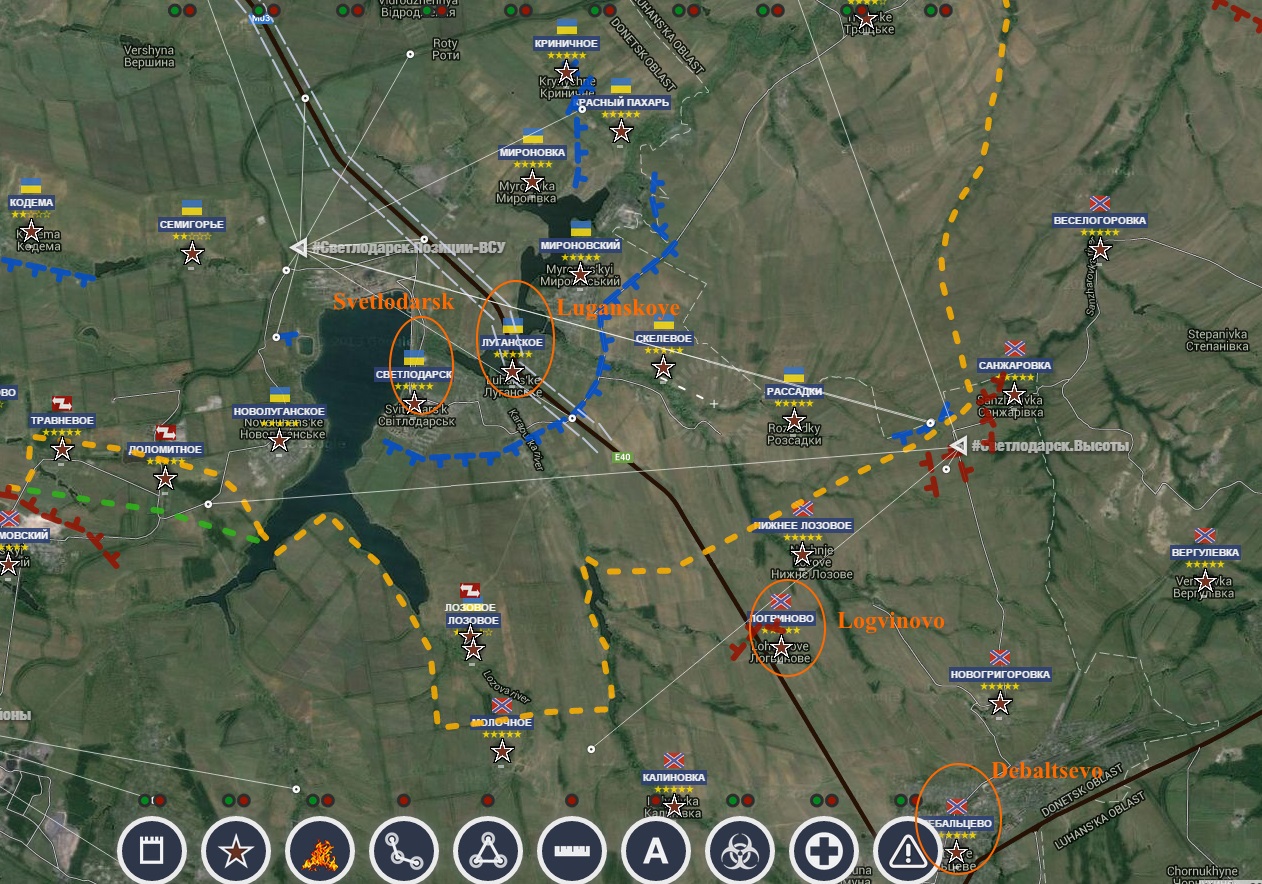
The Twitter comments started on June 3, as they often do on social media in this region, with people in one town calling out to see if people in another nearby town are alright.
Translation: @StarshinaZapasa in Gorlovka it’s not very loud for now. We’re hearing [firing] in #Svetlodarsk. In Donetsk, Tekstilshchik [district] got it hard. For now it’s not clear if there will be anything else.
Translation: Svetlodarsk view on to Luganskoye now.
The church in the picture is located here.
The blogger @chernyvaya said she was looking toward Luganskoye (Lugans’ke) in the Donetsk Region, not to be confused with the large city of Lugansk in Lugansk Region.
As a pond is visible in front of the church and the larger spire of the church is on the left, the view must be looking south across the pond from the road approximately here on Google maps.
Here’s a similar picture posted to Panoramio by Alex551 located here
Translation: Apparently yesterday’s [shelling] was not enough. The orcs have awoken once again. Shelling over Luganskoye. Svetlodarsk hears loud booms, black smoke is visible.
Ukrainian bloggers often call the Russian-backed separatists “orcs” as in Tolkien’s books.
Translation: #Svetlodarsk from VKontakte: “WTF. Floor shaking” 12:20 “Smokes in the area of the church and on the horizon, maybe it’s Krasnoye.” “Tank battle. It’s simply right near.”
This is the first indication that the smoke people are seeing is a tank battle.
Translation: Svetlodarsk shelling of environs at 12:00.
This report says shells are landing at a Ukrainian checkpoint between Mironovka (Myronivka) and Svetlodarsk.
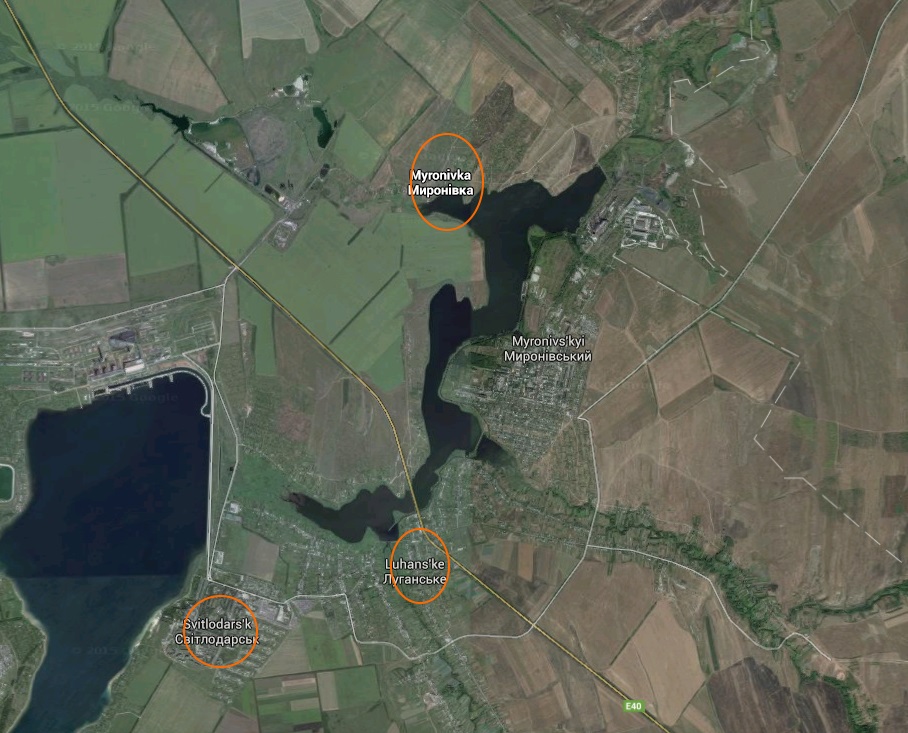
Translation: #Svetlodarsk VKontakte: “This is the Mironovka crossroads. From house no. 68 I see everything falling from there.” “They broke up the Mironovka crossroads, about 30 shells landed” 21:18.
Shelling continued the next day.
Translation: Today all evening they shelled #Luganskoye – homes burned on Stepnaya St. and Kalinina Street.
A local news site put some of these social media posts together, including some we translated here, and had this report explaining that the Russian-backed separatists were making a probe into Ukrainian territory in the direction of Artyomevsk, starting with Luganskoye and Mironovka (translation by The Interpreter):
“Today all evening they’ve been shelling Luganskoye — a house burned on Stepnaya St. and Kalina Street”; Right now the orcs are pounding hard on Luganskoye toward the east from Svetlodarsk. “That means tomorrow they will strike Novoluganskoye,” local residents suggest.
Furthermore, a Gorlovka resident says that a battery of terrorists’ Grads are deployed at the village of Gol’ma (Golemsky). “Shots” directed at Mironovka and Svetlodarsk. Communications with the village is extremely bad, which happens when Russian radio signal jamming systems are turned on. And that, as residents believe, is the presage of preparation for a massive storming on the part of the fighters.
Even so, the fighters in Debaltsevo do not advise local residents to replace the glass in windows broken by shards during the battles for Debaltsevo.
As lastnews reported earlier, in the next days, the DNR fighters are planning to begin a new widescale offensive. All civilians are being discharged from hospitals, unlawful military formations have been put on alert, a Pantsir has appeared this morning in the hangers at the Stirol plant, which came from the direction of Donetsk.
While there are reports also describing the Ukrainian forces shelling, enough of the tweets put together emerge to explain, as with the offensive on Marinka, that this was yet another push at Ukrainian defenses.
Yet it’s very hard to get across these facts to local people reliant on Russian state TV, as this blogger explains:
@mariinka_UA @lenschikk @tewton44 they always have it that the UAF ALWAYS starts first, without changes. According to them, the UAF is constantly shelling itself. They see that as advantageous to them.
Translation: The bottom. @FreeGorlovka A relatives phoned from Gorlovka (73 years old, no Internet, news only from Russian TV), and says, listen, why did the UAF attack Marinka, it’s theirs after all, isn’t it?
This blogger likely has understood what is likely to happen:
Translation: @chernaykoshka8 on the map of battles Gorlovka is a place d’armes from which Svetlodarsk can be taken in a kettle, or Gorlovka itself can be taken in a kettle.
This sarcastic tweet of a post from a fighter suggests that attacks continue:
Translation: Bad luck for the Dillweeds this morning. #Ukraine #Logvinovo #Debaltsevo
#Svetlodarsk #Poroshenko #War #Maidan #Anti-Maidan #CabMin
09:06:15 Report from militiaman with the call sign “Smersh” (“Whirlwind”)
“Today,
June 9, 2015, early in the morning the UAF shelled with artillery from
the area of Svetlodarsk on Logvinovo. But then things didn’t work out
for them (UAF) (if you catch my drift) and everything around went up in
smoke and smelled of burnt dillweed. As a result a certain amount of
equipment and personnel of the enemy were self-destroyed.
“Dillweed”
is a pejorative term used by the separatists about the Ukrainians based
on the similarity of the word ukrop (dillweed) and Ukrainian.
This area bears watching to see if there are further developments.
— Catherine A. Fitzpatrick